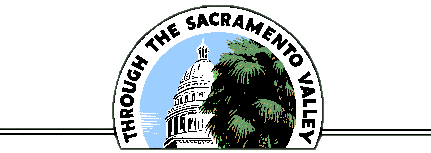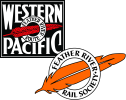MODERN FREIGHT CARS OF THE SN
When World War II ended, the Sacramento Northern's freight car fleet was a rolling museum. The newest cars were built in the 1920s. Others dated from as early as 1907. Every freight car the railroad owned was equipped with arch bar trucks and K-brakes. Beginning in 1955, the Western Pacific extensively modernized the SN freight car fleet, and that of its other subsidiary, the Tidewater Southern. Few 1950s-1960s shortlines were so well equipped with state-of-the-art cars as the SN and TS.

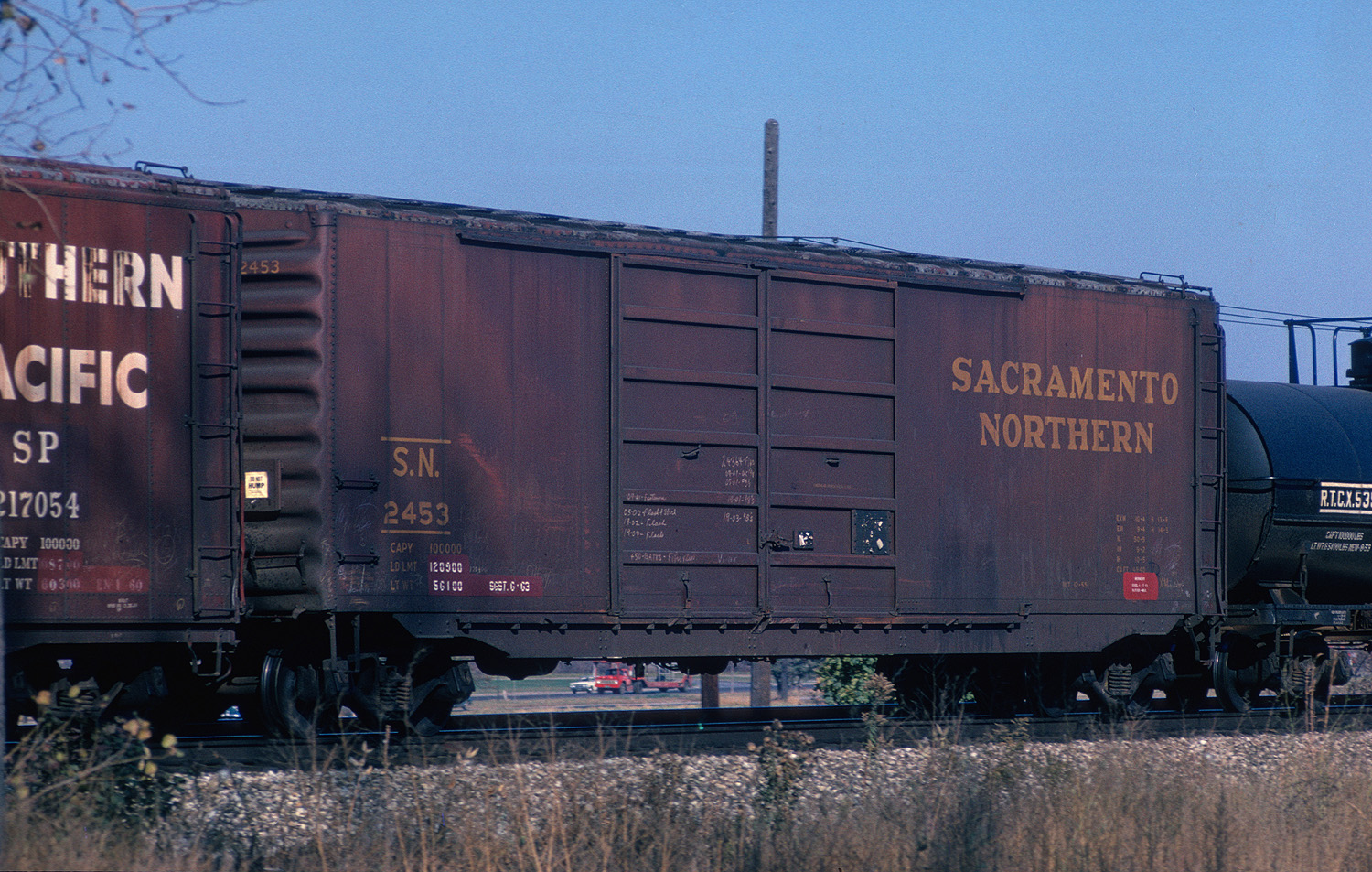
Emory J Gulash photo.
The SN's first truly modern cars were 50-foot, double-door boxcars built by Pullman Standard in 1955. This series was numbered 2401-2500. These were the famous PS-1 design, and were nearly identical to the WP's newest boxcars. Their only oddity was Superior panel doors, common on 40-foot PS-1s, but rarely seen on 50-foot double-door cars. Unlike many of their WP cousins which were fitted with special racks for parts service to the Ford assembly plant at Milpitas, the SN boxcars were classed as XM general service cars and were used for unrestricted loading to any destination in the country.

In 1958 American Car & Foundry built 20 GS drop-bottom gondolas for the SN, numbers 4001-4020. Like WP's own steel drop-bottom gondolas, the SN cars were big, much larger than similar Southern Pacific cars. They had an inside length of 45 feet, 10 inches, and a capacity of 2410 cubic feet.
These gondolas provide a clue to why the WP purchased freight cars for their subsidiaries. The WP wanted 100 gondolas for themselves, but only had enough money the budget for 75. However, both the SN and the TS had cash on hand, and paid for part of the whole 100 car order. Besides the SN's 20 cars, the TS received five numbered 201-205. Whether this sort of deal applied to other SN cars is not known for certain, but considering the WP's usual shaky finances, it is certainly possible.

The first batch of SN covered hoppers, numbered 5001-5010, were delivered by AC&F in February 1958. These were monster cars for their time, with a 47-foot length and a 3200-cubic foot volume. A similar block of Pullman Standard PS-2 cars soon followed in May 1959, numbered 5011-5020 at 3219 cubic feet. Finally in March 1960, AC&F supplied 5101-5110 at 3500 cubic feet. The latter two groups were equipped with roller bearing trucks, which were also used on most subsequent SN cars. These hoppers were likely used in rice service, especially from Conaway Farms near Woodland, but may also have been used to ship bulk walnuts from Walnut Creek to Stockton during the harvest season. More often they were found in WP service.
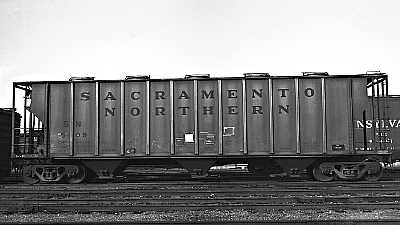
AC&F built more gondolas for the SN in 1959, numbered 4501-4525. These were 52-foot, 6-inch type GB drop-end mill gondolas. They used welded construction, and were duplicates of WP 6801-6825. Unlike many other WP mill gondolas, the SN cars did not have coil racks for Geneva-Pittsburg service. They apparently ranged all over the country carrying finished steel products, but they were stenciled for return to Pittsburg. Cars in this group were equipped with "sleeve-type cartridge bearings".
AC&F also contributed another group of jumbo covered hoppers in November 1961, which were numbered 5501-5510. These were built of aluminum and were the confusingly named "cylindrical teardrop" design. They were 56 feet long, with a whopping 3950-cubic foot volume. Their weight capacity was 100 tons, the heaviest of any SN cars, and must have been awfully hard on the line�s aging track (if they were ever on home rails). This class carried "SN" reporting marks and numbers, but were marked with large "Western Pacific" lettering on their flanks. Originally there were 10 cars in this group, but in 1963 the SN added AC&F demonstrator SHPX 72000 as their 5511.
WP lettering and slogans were also used on the SN's bunkerless refrigerators built by Thrall Car Company in December 1961. These were delivered in two groups, 8001-8010 with National C-3 cushioned underframes, and 8011-8040 with Keystone Shock Control underframes. Both had an inside length of 50 feet, and a 4477-cubic foot volume. They featured insulation, Superior plug doors, and four or six-belt cross-member loading devices. They were often used to carry canned goods from the many food processors served by the SN and the WP, and were known by the crews as "grocery boxes".
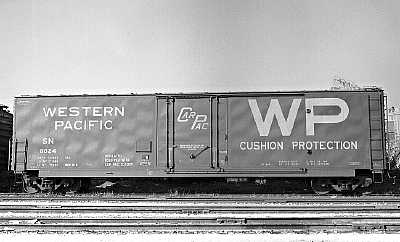
The SN's last new cars were certainly oddities for a shortline. Two 60-foot auto parts boxcars with cushioned underframes were built by Thrall in 1969. These were numbered 3735-3736, follow-on numbers to similar cars built for the WP. A similar car, 3737, was the first car in a small 1970 WP series from Maxon. These three SN cars filled the gap between two blocks of WP auto parts boxcars. The SN cars were classified as XP, and they probably joined their WP sisters in pool service to the Ford plant at Milpitas. It is doubtful if they were ever on SN rails. These three odd SN cars in a WP number series seems to suggest that the WP was again unable to raise all the money they needed to buy their own cars and had to depend on the SN to complete the deal.
Photos of SN cars on home rails are something of a rarity. Most SN cars were mixed with similar WP types, and roamed freely across the entire country. Anywhere on the WP system was considered home-road territory, so SN cars rarely returned to their own rails. Indeed, some of the cars, especially the auto parts boxes, may never have rolled a wheel on SN track, though this didn't matter much to the WP management. SN covered hoppers and the bunkerless refrigerators were the most likely to be found on home rails, but even then only during harvest and canning seasons. Home station for the mill gondolas was the SN's track at the U.S. Steel mill in Pittsburg, but they would almost never have been seen anywhere else on the SN. A number of SN cars were wrecked on other railroads over the years, which certainly demonstrates that most ranged widely.
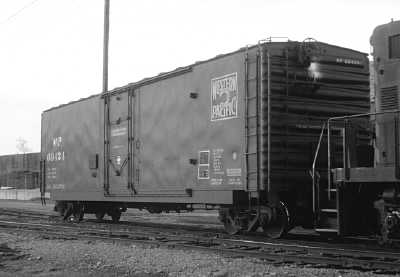
In the mid-1970s, the WP decided to end the SN's separate identity, and SN cars were renumbered into the WP roster. Renumbering began about 1975 and reached its peak in 1977, although some cars were already in dead storage or retired and were probably only renumbered on paper. For example, in the mid-1970s many SN PS-1 boxcars were stored on WP's dead line at Spring Garden with their original reporting marks, and some undoubtedly were scrapped without actually being relettered. New WP numbers corresponded to the original SN numbering scheme, and rather than compress the series, gaps were left where cars had already been retired or lost to wrecks. Most SN cars kept their fading display lettering, but their reporting marks were crudely painted over with a simple "WP" and new numbers. The Thrall bunkerless refrigerators were the major exception, as these were extensively rebuilt in 1979 and were completely repainted in the WP's revived square feather herald scheme.
Renumbering was as follows:
- PS-1 Boxcars, SN 2401-2500 to WP 35801-35900
- GS Gondolas, SN 4001-4020 to WP 9776-9795
- Mill Gondolas, SN 4501-4525 to WP 6826-6850
- AC&F Covered Hoppers, SN 5001-5010 to WP 11526-11535
- PS-2 Covered Hoppers, 5011-5020 to WP 11536-11545
- AC&F Covered Hoppers SN 5101-5110 to WP 11551-11560
- AC&F Covered Hoppers SN 5501-5510 to WP 11741-11750 (SN 5511 is not shown on the renumbering lists)
- Bunkerless Refrigerators, SN 8001-8040 to WP 60401-60440
- Auto Parts Boxcars, SN 3735-3737 to WP 3535-3537

The Union Pacific found that most of the ex-SN cars the inherited from the WP were worn out and beyond repair. Many were quickly scrapped, particularly the surviving PS-1 boxcars and the GS gondolas. Some of the bunkerless reefers, the auto parts boxcars, a few covered hoppers and some mill gondolas continued to serve the UP with WP reporting marks into the 1990s. As of November 2002, auto parts boxcar WP 3735 (ex-SN 3735) and mill gondola WP 6842 (ex-SN 4516) were still in revenue service. Gondola WP 6834 (ex-SN 4508) was in company materials service in Oregon. Auto parts boxcar WP 3736 (ex-SN 3736) was in dead storage at Blue Island, Illinois, and gondola WP 6839 (ex-SN 4513) was likewise stored dead in Huntington, Oregon.
Special thanks to Bob Campbell, Jim Eager and Eugene Vicknair for their help with this story.
